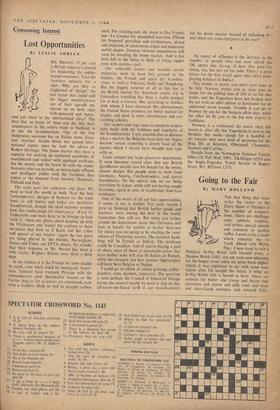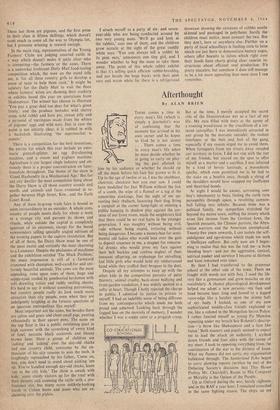Going to the Fair
By MARY HOLLAND These last three are pigeons, and the first prize in their class is fifteen shillings, which doesn't seem much to come all the way to Olympia for, but I presume winning is reward enough. In the main ring, representatives of the Young Farmers' Clubs are judging assorted cattle in a way which doesn't make it quite clear who is competing—the farmers or the cows. There
is a somewhat irrelevant Daily Mail food-tasting
competition which, the man on the stand tells me, is 'for all these country girls to develop a sense of taste to help them cook.' It might be
salutary for the Daily Mail to visit the floor where farmers' wives are showing their cookery
in exhibits based this year on quotations from Shakespeare. The winner has chosen to illustrate 'You pay a great deal too dear for what's given freely,' and the produce includes wild cherry soup, wild -rabbit and hare pie, rowan jelly and a pyramid of meringues made from the whites of pigeons' eggs and wild nuts. Just in case the point is not entirely clear, it is rubbed in with a backcloth illustrating 'the supermarket v. nature.'
There is a competition for the best inventions, the entries for which this year include an auto- matic gizzard-splitter, an egg dry-cleaning machine, and a cream and yoghurt machine. Agriculture is our largest single industry and ob- viously there is a proper concentration on func- tionalism throughout. The theme of the show is 'Good Husbandry in a Mechanised Age.' But for any city dweller the most compulsive thing about the Dairy Show is all those country sounds and smells and animals and faces crammed in to- gether between High Street, Ken., and the Earls Court Road.
Any of these in-group trade fairs is bound to seem extraordinary to an outsider. A whole corn, munity of people meets daily for about a week in a strange city and pursues its shows and rituals, while outside the capital is completely ignorant of its existence, except for the bored newsvendors selling specially angled editions of the evening papers to the captive circulation. But of all of them, the Dairy Show must be one of the most exotic and certainly the most charming to a Londoner. Despite the phalanxes of machines and the exhibition entitled 'The Muck Problem,' the main impression is still of a farmyard crammed with champion, well-cared-for and uni- formly beautiful animals. The cows are the most appealing, rows upon rows of them, huge and soppy-eyed, tended by gumbooted herdsmen with soft drawling voices and ruddy smiling cheeks.
It's hard to say it without sounding patronising, but country people really do look much more attractive than city people, even when they are indulgently laughing at the fatuous questions of an ignorant metropolitan like myself.
Most Important are the cows, but besides there are calves and goats and clean small pigs, panting exhaustedly in their square pens. The noise on the top floor is like a public swimming pool in high summer with the screeching of every kind of fowl, neurotic black cockerels and, blousy brown hens. Here a group of children are 'oohing' and `aahing' over the day-old chicks and one country child, overcome by the en- thusiasm of his city cousins to join the mob, is laughingly reproached by his father, 'Come on, boy, you don't need to stand about picking 'em up. You've handled enough day-old chicks, leave 'em to the city kids.' The show is awash with kids : some sturdy visitors up for the treat with their parents and assessing the cattle with a pro- fessional eye, but many more unlikely-looking locals in Cuban boots and jeans who are ex- claiming over the piglets.
I attach myself to a party of six- and seven- year-olds who are being conducted around by two very young nuns. 'We'll go and look at the rabbits,' says one of them, and the children grow ecstatic .at the sight of the great cuddly white toys. 'You can always tell a rabbit by its pink ears,' announces one tiny girl, and I wonder whether to beg the nuns to take them away. The point of this whole rabbit exhibit is that it's selling quick efficient rabbit-breeding, and just beside the huge bucks with their pink ears and warm white fur there is a refrigerated showcase showing the carcasses of rabbits neatly skinned and packaged in polythene. Surely the children must notice, must connect the two. But they don't, here or anywhere else. Further on a party of local schoolboys is feeding corn to hens which are just there to demonstrate battery cages, others offer biscuits to calves which right over their heads have charts giving clear concise in- structions about efficient veal -production. It's pretty macabre, but somehow it does still manage to be a lot more appealing than most zoos I can remember.

































 Previous page
Previous page